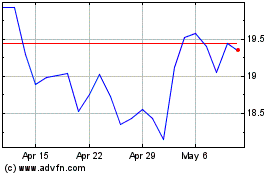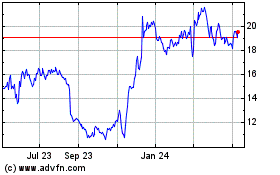U.S. Jobless Claims Rise Modestly to Start Year -- Update
January 12 2017 - 10:38AM
Dow Jones News
By Eric Morath
WASHINGTON -- The number of Americans who applied for first-time
unemployment benefits rose last week from near a four-decade low,
but the figure remains at a level indicating steady job
creation.
Initial jobless claims, a measure of how many workers were laid
off, increased 10,000 to a seasonally adjusted 247,000 in the week
ended Jan. 7, the Labor Department said Thursday. Economists
surveyed by The Wall Street Journal expected 255,000 initial
claims.
Claims for the prior week were revised up by 2,000 to 237,000.
That was still the second-lowest reading since 1973.
The data indicates layoffs remain subdued despite recent
announcements from Macy's Inc., Sears Holdings Inc. and other large
employers that they are reducing staff.
"Jobless claims remain in a very constructive range and are
still evidence of an environment in which turnover is low and
employers are generally content to maintain and expand their
payrolls," said Jim Baird, chief investment officer at Plante Moran
Financial Advisors.
Swings in claims data around holidays aren't unusual. During
those periods, jobless claims figures can be difficult to
seasonally adjust due to calendar variations. Unadjusted data shows
that claims typically peak during the first few weeks of the year.
Labor Department economists reported no special factors that may
have distorted the latest week's data.
The four-week moving average of adjusted claims, which evens out
weekly volatility in the data, fell by 1,750 to 256,500 last
week.
Initial jobless claims fell fairly steadily since reaching a
peak in 2009, during the final months of the recession, until last
year, when they plateaued near the lowest levels since the
1970s.
Claims have held below the 300,000 mark for 97 straight weeks,
the longest streak since 1970. A low level of layoffs typically
coincides with hiring.
U.S. employers have added jobs for 75 straight months, through
December. That is the longest streak since at least 1939.
The rate of job growth did slow last year, as the unemployment
rate fell to its lowest level in about a decade and wage gains
showed signs of improving. Those could be indications the economy
is nearing full employment, or the point where nearly all workers
who are seeking a job have found one.
Thursday's report also showed continuing unemployment claims,
reflecting benefits drawn by workers for longer than a week,
decreased 29,000 to 2,087,000 in the week ended Dec. 31. Data on
continuing claims are released with a one-week lag.
Write to Eric Morath at eric.morath@wsj.com
(END) Dow Jones Newswires
January 12, 2017 10:23 ET (15:23 GMT)
Copyright (c) 2017 Dow Jones & Company, Inc.
Macys (NYSE:M)
Historical Stock Chart
From Mar 2024 to Apr 2024

Macys (NYSE:M)
Historical Stock Chart
From Apr 2023 to Apr 2024
